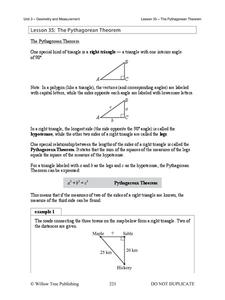Curated OER
Then What Happened?
Young scholars complete activities about the story "Diary of a Worm", by Doreen Cronin. In this reading comprehension instructional activity, students make predictions and apply prior knowledge about the topic of the story. They actively...
Curated OER
Balloon Ball Bounce
Students explore the rebound of balls. In this energy conversion lesson, students explore the physics behind the rebound of various types of sports balls. Through the experimental design process using balloons, students investigate and...
Curated OER
Build a Better Bouncer
Students experiment with silly putty. In this chemical changes lesson students work in groups, perform tests and collect data.
Curated OER
Touch and Feel Box
Students investigate their sense of touch to help become more descriptive with their observations. In this sensory lesson, students reach inside a box to feel an object then guess what it is. Students then use both senses of touch and...
Curated OER
Pythagorean Theorem
Students solve problems using the Pythagorean Theorem. For this geometry lesson,students identify the right angle, hypotenuse and legs of a right triangle. They find the missing sides using the ratios of the Pythagorean theorem.
Curated OER
The Pythagorean Theorem
Seventh graders relate the Pythagorean theorem to the real world. In this algebra lesson, 7th graders identify important properties of the Pythagorean theorem and use it to solve word problems. They create a step by step plan to help...
Curated OER
The Slope of a Curve
Learners graph the slopes of a line using the intercepts. In this precalculus lesson, students identify the properties of a curve slope. They find the limit and use a graping calculator to graph their lines.
Curated OER
The Raw of Newton’s 3rd Law
Students identify the action and reaction forces acting on the CEENBoT. In this physics lesson plan, students describe everyday applications of Newton's 3rd Law. They create a cluster word web about this law.
Curated OER
A Sphere and Its Net
Students identify and sketch the nets for sphere. In this geometry instructional activity, students differentiate between two and three dimensional shapes. They find the surface area of each sphere.
Curated OER
Big Hat People
Students investigate visual arts by reading a children's book in class. In this collage lesson, students read the book by Keith Haring titled Big and discuss the themes and settings. Students discuss how adjectives are used to describe...
Curated OER
Fortunes and Wealth
Students work together to examine how Americans acquired their fortunes. They compare and constrast the different levels of wealth. They discuss the power that wealth can bring as well.
Curated OER
Batty Facts
Students complete a chart which includes what they know about bats, what they want to know, and after conducting research on the Internet and in books, what they learned about bats.
Curated OER
WHY WE AREN'T FILTER FEEDERS
Young scholars describe three methods of obtaining food: scavenging, filter feeding, and hunting. They describe three methods of obtaining food: scavenging, filter feeding, hunting, and list at least two reasons why humans are not...
Curated OER
Potential Effects
Young scholars use the Internet to reserch the effects of climate change. Using that information, they relate those effects to specific items in the environment. They discover how climate changes affect their lives now and in the future.
Curated OER
Nonprofits in Our Community
Young scholars identify nonprofit organizations within their local community. They practice using the yellow pages to locate these organizations. They use an organizer to keep all of the information they gathered organized.
Curated OER
Nonprofit and Profit Careers
Learners examine the difference between profit and nonprofit organizations. They identify careers that are available in each sector as well. They develop their own questions and interview people who are in those careers.
Curated OER
Motion Capture and Analysis
Students capture the serve motion of a tennis player with a digital or video camera. Using transparencies or a software package, analyze the speed, acceleration, displacement and time of the racquet head and ball in the tennis stroke.
Curated OER
Rock and Roll!
Students predict what happen to the rocks. They observe, describe, and record changes in rocks. They apply their learning by describing the forces that break down and wear away rocks.
Curated OER
LIGHTNING MYTHS AND FACTS
Students compose lightning safety rules and explore facts and fiction about lightning. They examine the cause of lightning when a channel nears an object on the ground, a powerful surge of electricity from the ground moves upward to the...
Curated OER
Couch Potato or Inertia Victim?
Sixth graders how primary research is carried out. They design a simple survey questionnaire to interview people about their week average television watching time. They analyze the results and write a report based on the information.
Curated OER
Types of Groups
Students are introduced to the various types of groups in a society. In groups, they create a chart showing the similarities and differences between primary, secondary, and reference groups. Using magazines, they cut out pictures...
Curated OER
"Working in a Hat Factory"
Students analyze the understanding of what a producer is. Students distinguish between producers and consumers. Students produce a hat of his/her own. Students will share creations with each other.
Curated OER
Extraordinary Compilations
Students discuss and record why people have various types of collections. They interpret the class collection of information then use details about the Morgan Dollar to understand what collection characteristics it may have.
Curated OER
The Buoyancy Factor
Students examine why some objects float in water while others sink and the ability of something to float does not depend entirely on its weight. Archimedes' principle is introduced and buoyant force is discussed. Practice calculations...
Other popular searches
- Math Baseball
- Baseball Cards
- Baseball Lesson Plans Math
- Baseball Elementary
- Baseball Statistics
- Baseball Children
- Baseball Lesson Plans
- Baseball Review Game
- Major League Baseball
- History Baseball
- Baseball Words
- Baseball Grade

























